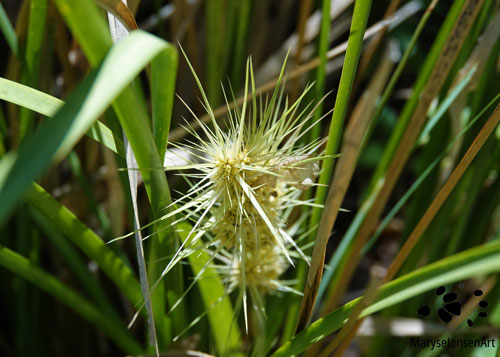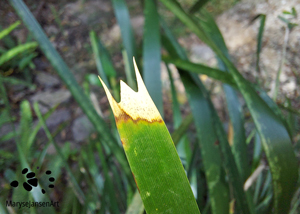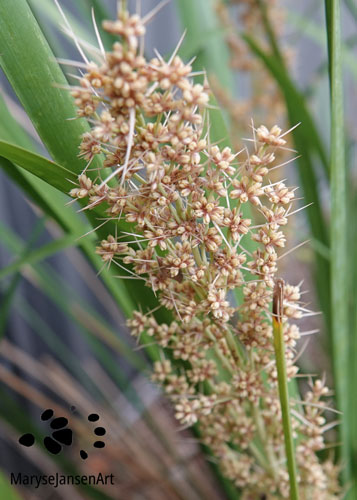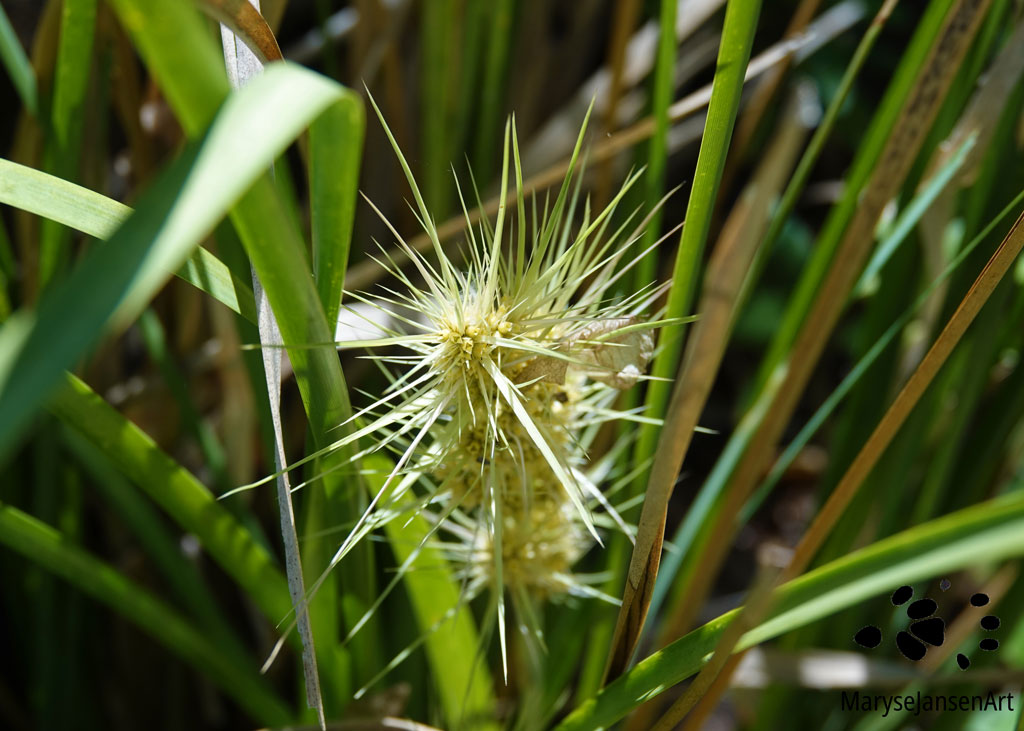Wildflower Photography with marysejansenart
The grassy plant also known as Spikey-headed Mat Rush

Lomandra longifolia looks like a simple clump of thick, long grass but there is a lot more to it! The flowers are fascinating in the least! The common name of this plant is Mat Rush, or Spikey-headed Mat Rush – you can see why when you look at the featured image! Sometimes it’s also known as Basket Grass. It’s a native Australian herb, mostly found throughout eastern Australia.
Table of Contents
Chewing the leaves of Lomandra longifolia
The first time I learned about this plant was during a bush-tucker walk at the local Environment Centre, in a similar way to how I was introduced to the Wombat Berry.
Our guide pointed out that the strappy leaves are very long, up to 1m! They are a glossy green, about 1cm wide, very firm and flat. The tips of the leaves are prominently toothed. This helps us to distinguish between the various types of Lomandras. A leaf from the Lomandra Longifolia has typically 3 teeth, the middle one shorter than the outer two which kind of makes it look like a crown. The base of the leaf is a bit broader then the rest of the leaf and is yellow/white in colour.

He took a fresh leaf from the centre of the clump and showed us the base. He explained that Aboriginal people would chew on the base of the leaf when they feel hungry and there is nothing to eat. It would still their hunger sensations for a while. He lets me try. It tastes a bit like fresh baby peas, not bad!
Warning
Bush–tucker means any wild animal, insect, plant or plant extract, etc traditionally used as food by native Australians.
Before you have a go at trying any type of bush tucker I have to give you an important warning! Some bush tucker plants are very similar to other plants that may contain poisonous compounds. These plants could make you ill when consumed, or even lead to death. Even when you do correctly identify the plant, a minority of people may experience an allergic reaction to certain substances in the bush tucker that are harmless to most people. In some cases, the bush tucker needs appropriate preparations before it can be consumed safely.
A safe way to explore bush tucker is to buy seedlings of bush-tucker plants at a native nursery and plant them in your garden. Some of these nurseries may organise workshops and bush-tucker tastings to help you choose. If you don’t like the taste of it after all, the native animals will definitely be grateful that you planted it in your backyard! And you will be able to enjoy their company and perhaps some of the other uses of the plant!
Grinding the seeds of Lomandra longifolia
The Mat Rush has another bush-tucker use. In the featured image you can see the clustered flower head with the creamy-brown coloured flowers which are protected by sharp spikes! As the flowers wilt, the brown seed capsules remain. They provide another use of this plant for Australia’s indigenous people. They would harvest the seeds and grind them into a meal to cook damper.
It looked to me like a very delicate and time-consuming job to harvest the seeds from between all those spikes! In later years I once tried it with the plant in my own garden, it was as difficult as I had imagined!

Weaving baskets
Apart from being a great source of bush-tucker, Lomandra longifolia has some other uses as well. During a workshop that was run by an Indigenous lady at our local museum I learned how the plant is also used to weave baskets. The leaves would be harvested, split, tied in bundles and then soaked to make them pliable for weaving. It’s very strong so it’s perfect for weaving baskets, dilly bags, traps and even shelters!
It takes a lot of time and great skill to create these items but imagine what a sustainable alternative this is to our plastics! Note, however, that when taking natural resources like this one, whether its for consuming or for creating utensils, it is important to do so consciously.
The indigenous people are well aware that is it important to only take part of a plant, so that it can regrow for future use. They know which parts of the plant and how much a plant can miss to still be able to survive. Never take more then what you really need. Don’t strip all the plants in one small area, but spread.
If you want to try this yourself you also need to be aware that you can’t just take from any plant. It is forbidden to take anything from National Parks and other protected areas. Only take from other places with permission. Ideally, plant them in your own garden!
Preventing erosion
Lomandras have yet another important function. They have extensive roots systems which do a tremendous job of keeping the soil together, even when water flows through an area. Therefore they are very useful in preventing erosion so they are often planted on slopes and on the banks of rivers and creeks. They will grow in a range of habitats, including sandy soils, swamps, rocky cliffs and open forest. Frost, heat and drought don’t deter them so it’s a very hardy plant and will also do well in most gardens.
I’ve certainly come to appreciate this plant with its weird spikey flowers, and you?
If you are interested in purchasing ‘Flowering Spikey-headed Mat Rush’ or would like to see what the image looks like on the various products, please head to my shop.
The Lomandra longifolia is featured in the latest episode of ‘Come for a Walk in the Australian Bush’. Make sure you watch until the end to see it as there are many other interesting things to discover!


